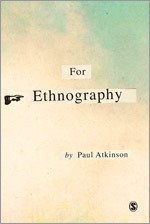Writing The Ethnography Quartet
by Paul Atkinson, Ph.D., Emeritus Professor of Sociology at Cardiff University.
Dr. Atkinson is the author of The Ethnography Quartet, four books from Sage: For Ethnography, Writing Ethnographically, Thinking Ethnographically, and Crafting Ethnography. Use the code COMMUNITY3 for a 20% discount when you order her books from Sage, valid worldwide until March 31, 2024.
Why a quartet?
I never intended to write a quartet of books about ethnography. Even when I had published the first two I did not envisage a third and a fourth. But between 2015 and 2022 Sage and I produced the four books. How and why did that happen, and what did I want to achieve? I had, of course, written about ethnographic research before, and the book with Martyn Hammersley had proved to be quite influential (Hammersley and Atkinson 1983), and has gone into its fourth edition (2019). To begin with, I really wanted to write a personal book, part manifesto, promoting a particular view of ethnographic research. Why? After all, there were by 2015 plenty of books about ethnography and how to do it. Ethnographic fieldwork and analysis had become widespread, part of the yet broader popularity of qualitative research. It was partly that very popularity that made me want to write. I wanted to assert what I think are some basic and fundamental commitments that ought to inform the conduct of ethnography.
For Ethnography
To put it simply: there is too much ‘qualitative’ research that gets called ‘ethnographic’, but really isn’t. Moreover – and partly as a consequence – there is a great deal of qualitative work that is, frankly speaking, not very good. Just because something is qualitative, that does not guarantee quality. Too much is weak and sloppy. A series of under-analysed interviews – for instance – does not constitute an ethnography, and is not very good by whatever label. In most cases, it doesn’t add up to very much. So I wanted to assert what I believe to be some basic principles. My books have never been devoted to ‘how to do it’ text-book style. Rather, in For Ethnography and throughout the quartet I have tried to concentrate on ‘how to think about it’.
For Ethnography affirms the kind of intellectual and personal commitments called for in ethnographic fieldwork. It is not just a matter of being in ‘the field’ for a length of time, or of some vague appeal to ‘immersion’. Equally, ethnography doesn’t lend itself to step-by-step instructions (with all respect to authors who have approached it in that way). It does depend on a serious, well-informed understanding of how everyday life is accomplished. It demands close attention to the forms and modalities of social organisation and social action. It is not a matter of subjective ‘meanings’ alone, nor is it an exercise solely in learning to see a social world ‘from the natives’ point of view’. It calls for the disciplined analysis of patterns of social interaction, of forms of discourse and narrative, of the ordering of time and space, and of the forms of material culture. All of that - and more – calls for a sustained attention to the detail, the fine grain, of everyday life. It includes analysis of actors’ tacit knowledge and their embodied competence. Far from being impressionistic, such an approach to ethnography produces systematic, even formal, analytic accounts. In its close attention to the gine grain of everyday life, I describe it as granular ethnography.That perspective may strike some readers as a steampunk approach. If so, I embrace steampunk ethnography.
Thinking Ethnographically
The same prspective informed the second book in the quartet. Thinking Ethnographically (2017) was not originally conceived as part of any series. It had originally been planned as a ‘key concepts in ethnography’ book and had been drafted as about forty 1000-word essays. But my then SAGE editor, Mila Steele, persuaded me to rework the draft to make a ‘proper’ book of it, suggesting that key concepts books were ‘a bit last year’. It meant a thorough rewrite and expansion of what I had drafted, but it was worh it. At the same time we agreed to produce that book with a cover design that continued the look and feel of the first. In the event, and building on that idea, the four volumes’ covers allude to four elements: Earth, Air, Water and Fire. I like the resulting designs very much. Thinking Ethnographically continued my aim of helping researchers think about their materials: how to make sense of their observations. The ‘key concepts’ were re-packaged and presented in terms of major analytic schemes and concepts. I wanted to help the inexperienced ethnographer who had collected a lot of data (probably too much) but had little idea of what to do with them. My view then, as now, was that researchers do not need elaborate protocols of ‘coding’ or ‘thematic analysis’ in order to make sense of their research. Rather, I suggested that what many actually need is ideas. Of course, in the ideal world they would all be original ideas, developed by researchers themselves. But in order to ‘have’ ideas one really needs a repertoire of ideas to develop, build upon, and generally think with. Indeed, I always insist that ‘data’ are materials to think with and think about. Consequently, Thinking Ethnographically explores a variety of ideas that have been central to the ethnographic imagination for decades, drawn eclectically from a variety of sociological and anthropological traditions.
Writing Ethnographically
Of course, ethnographers don’t just have to think and ‘analyse’. They have to write: to transform the social world(s) they have studied into sustained texts, often doctoral theses and monographs.So the third book in the quartet was Writing Ethnographically (2020). I had originally planned to do a new edition of my 1990 book The Ethnographic Imagination but I realised that so much had changed, including my own thinking, that a new text was needed. And so the books became a trilogy. Again, I was not interested in promoting just one ‘correct’ way of writing an ethnographic monograph or dissertation, but in exploring how issues of style, rhetoric and genre inform how we can create versions of a social world. In all my writing and teaching about ethnographic writing I have tried to encourage people to think beyond conventionally realist styles, and to consider a wider range of literary models and genres. That is not because I want all ethnographies to be fashionably ‘postmodern’ or ‘subversive’, but if ethnographers are going to think about ‘writing culture’ and the culture of writing, then they really ought to be in a position to think about textual strategies in a well-informed way. Throughou my own work I insist that we understand the essential reflexivity of textual forms:social phenomena inform how we write, and how we write helps to construct how those phenomena are perceived, shared and understood.
Crafting Ethnography
Having initially thought I had completed a trilogy, I decided that a quartet would be classier. So I added Crafting Ethnography (2022). In a way it brought the books full circle. I wanted to stress that the conduct of ethnography is a craft. It calls for well-informed, practical activity. Like craft activities, such as glass-working, ethnography takes base materials – the mundane, ordinary stuff of everyday life – and transforms them into something different. It shapes and gives significance. It has something of alchemy in its practice I illustrated the book with my own ‘craft’ activities, such as ceramics, glass-blowing and silver-smithing. I took classes in those and other activities, as well as observing makers in their studios. This constituted a series of very short bursts oif participant observation. I wanted to illustrate craft through ethnography and ethnography through craft.
Some of the pieces I made as part of my 'craft' exercises - two bits of glass, a silver spoon and three little porcelain pots.
I also used those examples to try to show that one can often learn a lot from a little, and on the whole that is better than learning a little from a lot. That maxim of ‘learn a lot from a little’ has really been a recurrent thread throughout the quartet. It calls for careful, intense observation, equally intense analyic thought, and careful textual shaping. In Crafting Ethnography (p. 142) I summarise that perspective in this way:
Novice researchers seem to spend far too much time collecting ‘data’, and almost asmuch time worrying if they have got ‘enough’.… Ethnographic excellence is never achieved with lots of data. It obviously matters not a jot if you have lots of fieldnotes and/or interview transcripts if you hve no idea what to do with them, or if you do not use them to think with. Consequently, crafting ethnography is not about collecting lots of under-analysed data. It is just as much about learning more from a little.
References
Atkinson, P.(1990). The ethnographic imagination: Textual constructions of reality. London: Routledge, republished 2010.
Atkinson, P. (2015). For ethnography. London: Sage.
Atkinson, P. (2017). Thinking ethnographically. London: Sage.
Atkinson, P. (2020). Writing ethnographically. London: Sage.
Atkinson, P. (2022). Crafting ethnography. London: Sage.
Hammersley, M. and Atkinson, P. (1983). Ethnography: Principles in practice. London: Tavistock. 4th edition, London: Routledge, 2019.























Between 2015 and 2022 Paul Atkinson produced four books about ethnography. How and why did that happen, and what did he want to achieve? Learn about this quartet of books.